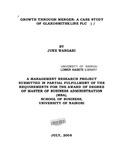| dc.description.abstract | Organizations today are faced with a lot of challenges. Globalization and
liberalisation of economies has put pressure on businesses, not to mention
increased demand from investors for higher productivity, greater efficiencies,
higher quality of goods and services and higher levels of innovation. As a
result, managers need to develop strategies that should gain them competition
advantage over their competition and possibly eliminate competition all
together.
This is a case study about the merger process and objectives of
GlaxoSmithKline (GSK) Plc whose aim is to provide an in-depth understanding
of how Glaxo Welcome and Smith Kline Beecham merged to form
GlaxoSmithKline Plc in 2001.
The objectives of the study are to document the process of the Glaxo Wellcome
and Smith Kline Beecham merger and to establish whether the merger
objectives were met.
Data for this study was collected through interviews of Senior Managers at GSK
and also by use of a non-structured questionnaire. Given the qualitative nature
of the data obtained, the mode of analysis used was content analysis.
The study findings indicate that the objectives of the merger were to take
advantage of rapid advances in scientific discoveries and technology and
increased consumer knowledge. The increased competition m the
pharmaceutical industry meant that it made economic sense for these two
powerhouses to merge and to combine skills and resources.
The study managed to document the process of the merger and also established
that the merger was a success and the objectives of the merger were met. The
study found that this was a merger where neither set of shareholders receives a
premium over the market value of their shares before the transaction is
announced and was termed as transaction of equals. On completion, GW
shareholders held approximately 58.75% of the issued ordinary share capital of
GlaxoSmithKline and SB shareholders held approximately 41.25%.
The study concluded that despite the fact that mergers have their own pitfalls,
certainly some mergers are a perfect fit of two companies which complement
each other's strengths, have obvious benefits and enable the companies to
make massive economies of scale. This enables them to win customers and new
business while keeping costs down and still fund the billions necessary for
research and development.
This study recommends that further research be undertaken to determine the
survival of mega mergers and establish the reasons for their post merger
survival or death.
Several limitations were encountered during this study. The merger process
was controlled from the United Kingdom and the people directly involved in
the merger are located there. However, it would have been very costly to
travel to the United Kingdom to obtain my interviews, not to mention that
getting appointments for interviews would have been very challenging. Also,
many people who were with the company then have since left to pursue
other interests elsewhere. I therefore had to contend with interviewing local
current management who helped piece together relevant merger information
verbally and from data published in the internal employee magazines. | en |

